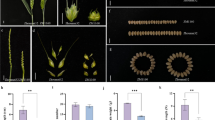Abstract
The linkage relationship between the semidwarf gene (sd-1) and the isozyme locus EstI-2 was elucidated using segregating populations derived from crosses between several semidwarf testers and tall rice varieties. Bimodal distributions for culm length were observed in F2 populations of three cross combinations, including Shiokari/Shiokari (sd-1), Taichung 65 (A,Pn,Pau)/Taichung 65 (sd-1), and Milyang 23/Kasalath. Taking the valley of the distribution curves as the dividing point, two height classes were apparent with a segregation ratio of 3 tall∶1 short, demonstrating this character to be under the control of a single recessive gene. An inheritance study of esterase isozymes, based on isoelectric focusing (IEF), showed that the EstI-2 locus had two active allozymes of monomeric structure and one null form, which were designated “a”, “b”, and “n”, respectively (Eun et al. 1990). Semidwarf testers such as Shiokari (sd-1), Taichung 65 (sd-1) and Milyang 23 have an active allozyme designated as EstI-2aa, while the tall parents, Shiokari and Taichung 65 (A,Pn,Pau), have the active allozyme, EstI-2bb, and Kasalath has a null form of the allozyme, EstI-2nn. By dividing F2 populations based on EstI-2 allozyme patterns, culmlength distributions exhibited trimodal curves. Most of the short plants had the homozygous EstI-2aa pattern of the short parents, most of the tall plants had the homozygous pattern, EstI-2bb or EstI-2nn, and most of the intermediate plants had the heterozygous EstI-2ab or EstI-2an banding pattern. Einkage analysis indicated that sd-1 and EstI-2 were tightly linked. These findings were also confirmed by segregation analyses in F3 progenies. No recombinants among 171 F3 families from the Shiokari/Shiokari (sd-1) combination, five recombinants among 267 F3 families from Taichung 65 (A,Pn,Pau)/Taichung 65(sd-1), and only two recombinants out of 237 F3 families from Milyang 23/Kasalath, were found. The recombination values were 0, 1.87 and 0.8%, respectively.
Similar content being viewed by others
References
Ahn SN, Bollich CN, Tanksley SD (1992) RFLP tagging of a gene for aroma in rice. Theor Appl Genet 84:825–828
Aihwai DS (1971) Semidwarf rice and wheat in global food needs. Quart Rev Biol 46:1–34
Ainsworth CC, Gale MD, Baird S (1984) The genetic control of grain esterases in hexaploid wheat. 1. Allelic variation. Theor Appl Genet 68:219–226
Aquino RC, Jennings PR (1966) Inheritance and significance of dwarfism in an indica rice variety. Crop Sci 6:551–554
Cho YG, Eun MY, Chung TY (1989) Organ specificity of esterase isozymes in rice (Oryza sauva L.). Research Report, Rural Development Administration. Korea Biotech 31(2):32–36
Choi HO, Bae SH, Chung GS, Cho CY, Heu MH, Beachell HM (1974) A new short-statured rice variety “Tongil”. The Research Reports of the Office of Rural Development Administration, vol. 16 (crop):1–12
David CC (1991) The world rice economy: challenges ahead. Rice biotechology (Biotech in Agriculture No.6) C.A.B. International in association with the International Rice Research Institute, pp 1–18
Eun MY, Cho YG, Chung TY (1988) Variation of esterase isozymes in rice (Oryza sativa L.) by isoelectric focusing. Research Report, Rural Development Administration. Korea Biotech 30(1):21–25
Eun MY, Kim YW, Cho YG, Chung TY (1989) Isozyme variation of phosphoglucose isomerase and malic enzyme in rice (Oryza sativa L.) by isoelectric focusing. Research Report, Rural Development Administration. Korea Biotech 31(4):1–5
Eun MY, Kim YK, Cho YG, Chung TY (1990) Inheritance of esterase isozymes in rice by isoelectric focusing. Korean J. Breed. 22(3):252–259
Helentjaris T, King G, Slocum M, Siedenstrang C, Wegman S (1985) Restriction fragment polymorphisms as probes for plant diversity and their development as tools for applied plant breeding. Plant Mol Biol 5:109–118
International Rice Research Institute (1967) Annual report for 1966, pp 59–82
Kinoshita T (1990) Report of the commitee on gene symbolization, nomenclature and linkage groups. Rice Genet Newslett 7:16–50
Kinoshita T, Shinbashi N (1982) Identification of dwarf genes and their character expression in the isogenic background. Japan J Breed 32:219–231
Kosambi DD (1944) The estimation of map distances from recombination values. Ann Eugen 12:172–175
Mackill DJ, Salam MA, Wang ZY, Tanksley SD (1993) A major photoperiod-sensitivity gene tagged with RFLP and isozyme markers in rice. Theor Appl Genet 85:536–540
McCouch SR, Kochert G, Yu ZH, Wang ZY, Khush GS, Coffman WR, Tanksley SD (1988) Molecular mapping of rice chromosomes. Theor Appl Genet 76:815–829
Oba S, Kikuch F, Maruyama K (1990) Genetic analysis of semidwarfness and grain shattering of Chinese rice variety “Ai-Jio-Nan-Te”. Japan J Breed 40:13–20
Pinthus MJ (1973) Lodging in wheat, barley, and Oats. The phenomenon, its causes, and preventive measures. Adv Agron 25:209–263
Ronald P, Albano B, Tabien R, Abenes ML, Wu K, McCouch S, Tanksley S (1992) Genetic and physical analysis of the rice bacterialblight resistance locus. Mol Gen Genet 236:113–120
Suh HS, Heu MH (1978) The segregation mode of plant height in the cross of rice varieties. II. Linkage analysis of the semidwarfness of rice variety “Tongil”. Korean J Breed 10(1):1–6
Tanksley SD (1983) Molecular markers in plant breeding. Plant Mol Biol Rep 1: pp 3–8
Walcott JJ, Laing DR (1976) Some physiological aspects of growth and yield in wheat crops: a comparison of a semidwarf and stadard height cultivar. Aust J Exp Agric Anim Husb 16:578–587
Yokoo M, Saito S (1986) Association between grain shattering and semidwarfness in rice. Rice Genet Newslett 3:63–65
Yu ZH, Mackill DJ, Bonman JM, Tanksley SD (1991) Tagging genes for blast resistance in rice via linkage to RFLP markers. Theor Appl Genet 81:471–476
Author information
Authors and Affiliations
Additional information
Communicated by F. Salamini
Rights and permissions
About this article
Cite this article
Cho, Y.G., Eun, M.Y., Kim, Y.K. et al. The semidwarf gene, sd-1, of rice (Oryza sativa L.). I. Linkage with the esterase locus, Estl-2 . Theoret. Appl. Genetics 89, 49–53 (1994). https://doi.org/10.1007/BF00226981
Received:
Accepted:
Issue Date:
DOI: https://doi.org/10.1007/BF00226981




